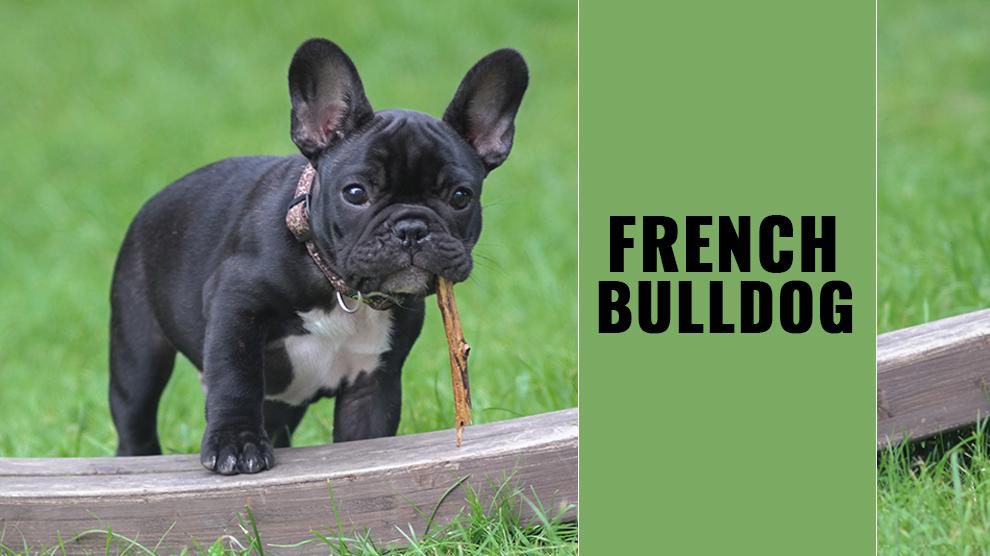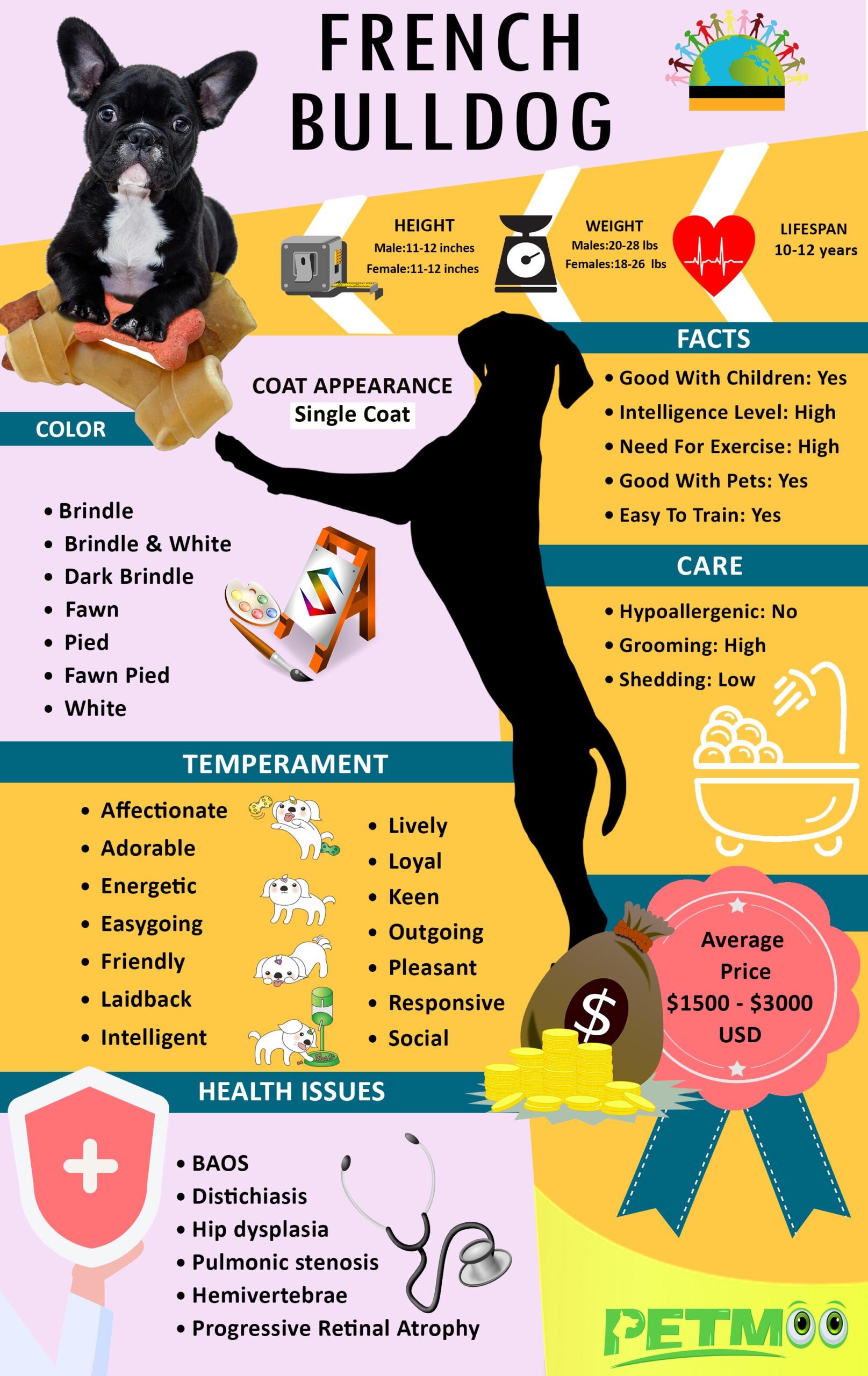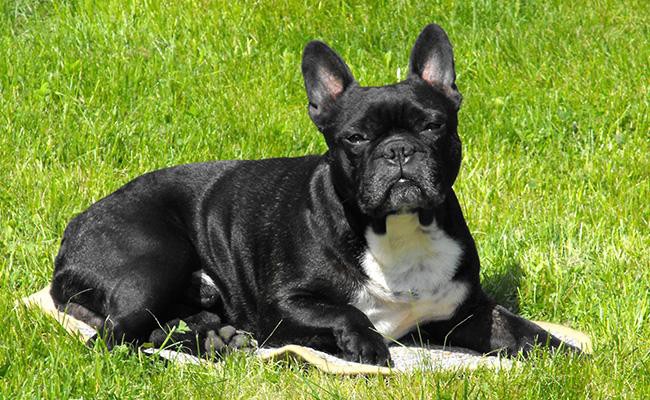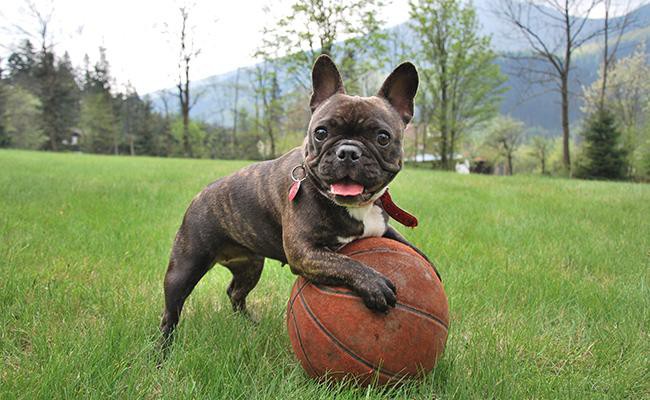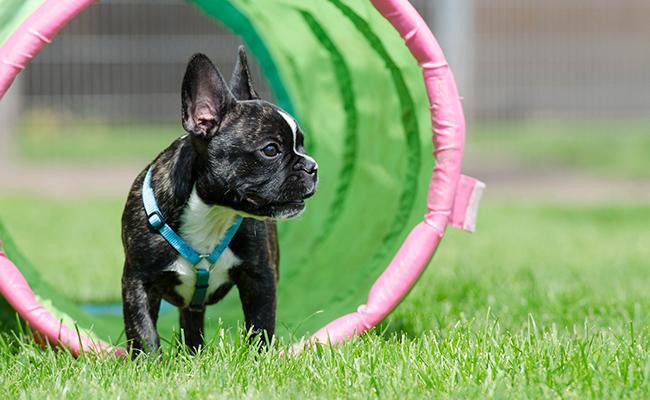- Breed Characteristics Sheet
- Is French Bulldog, The Right Dog For You?
- Infographic
- History
- Size And Lifespan
- Colors And Appearance
- Temperament
- French Bull dog Vs Boston Terrier
- Care
- Training
- Food
- Grooming And Shedding
- What Are Girl Dog Names For French Bulldogs?
- Health Problems
- Interesting Facts On French Bulldog
- Price And Breeders
Dog Pregnancy Calculator And Timeline
The bouledogues français, or more commonly the French bulldog with its compact bundle of a body and pryingly puckered face, soulful eyes, Snub nose, perky ears… might look like they’ve taken the odd punch to the face over the years, but they are irresistibly cute.
Who can resist that adorable smudgy face? Really, really beloved. The best thing about having a Frenchie is that they love you more than any other creature the universe could even conceive of.
The French bulldog’s dictum is “Love the one you’re with.” Nicknamed “Frenchies”, they are adaptable to any home environment, as long as it has air conditioning.
This very popular dog breed has boomed in fame in recent years and these cute little dogs are enjoying a serious comeback.
In the United States, Frenchies didn’t even rank in the AKC’s top 30 most popular breeds in 2007 and they catapulted to No. 4 in 2017. In Britain, they ranked 76th in 2005.
At the start of this year, they were in second place and in June 2018 they have overtaken the Labrador retriever as the UK’s most popular dog breed for the first time since records began.
French Bulldog Breed Characteristics Sheet
- Origin: France
- Size: Small
- Dog Breed Group: a Non-sporting group
- Purebred: Yes
- Lifespan: 10-12 years
- Height: Male – 11-12 inches (28 – 30 cm), Female – 11-12 inches (28 – 30 cm)
- Weight: Males – 9 – 13 kg (20-28 lbs) and Females – 9 – 13 Kg (18-26 lbs)
- Coat Appearance: Single Coat
- Coat Colors: Brindle, Brindle & White, Dark Brindle, Fawn, White and Fawn, Fawn With Black Mask, Light Brindle, Pied, Fawn Pied, White
- Temperament: Affectionate, adorable, Energetic, easygoing, Friendly, Laidback, Intelligent, Lively, Loyal, keen, Outgoing, pleasant, Responsive, Social, spirited
- Good With Children: Yes
- Intelligence Level: High
- Good With Pets: Yes
- Hypoallergenic: No
- Grooming: High
- Shedding: Low
- Barking: Barks when necessary
- Suitable For Apartments: Yes
- Need For Exercise: High
- Easy To Train: Yes
- Good For First Time Owners: Yes
- Health Issues: BAOS, hip dysplasia, Progressive Retinal Atrophy, Distichiasis, Pulmonic stenosis, Hemivertebrae
- Litter Size: 3-5 puppies
- Average Price: $1500 – $3000 USD (USA), £1500 for KC Registered, £1300 for Non-KC Registered (UK)
Is French Bulldog, The Right Dog For You?
If you want a dog who…
- Is small but strong – not a subtle lapdog
- Very adaptable, pleased to live in an apartment or house
- Has Low shedding and a sleek easy-care coat that comes in many colors
- polite with everybody, including other pets
- Intelligent, intrepid but mischievous
- Only need shorter walks rather than vigorous exercise requirements
- Doesn’t bark much and easy to train
A Frenchie may be right for you.
If you don’t want to deal with…
- snuffling, Snorting, snoring, wheezing, some slobbering
- Stubbornness and overly possessive of owners and families
- Sometimes irritable and may adopt “small dog syndrome “
- Quite a few potential health problems due to their ‘extreme physical features’
- Expensive nature as a well-bred, pedigree puppy from reputable breeders is costly
A Frenchie may not be right for you.
They were made for lovin’ you, buddy. You can adjust and change for the better. Still not convinced? Look at their face once…
French Bulldog History
This “clowns of the canines” origin are not clear, but most sources trace their roots to English bulldogs. The most accepted theory is that the French bulldog was bred to be the mini version of bulldogs in France.
Nottingham lace workers brought over to England during the 1800’s. What specific breeds were crossed with the English dogs is not clear (some say its Pugs and Terriers), but they did bring in the “bat ear,” which is not a characteristic of the English Bulldogs.
It was originally bred for working with bulls; the French bulldog primarily belonged to butchers, Parisian market porters, and coachmen during that period.
It soon won over the artistic world, French bohemians and society ladies in the early 19th century but after that, there is no looking back.
Recommended Read: Majestic Names For Your Male Dogs, Cute Names For Female Dogs
French Bulldog Size And Lifespan
French Bulldog Size
Height – Male – 11-12 inches (28 – 30 cm), Female – 11-12 inches (28 – 30 cm)
Weight – Males – 9 – 13 kg (20-28 lbs) and Females – 9 – 13 Kg (18-26 lbs)
French Bulldog Lifespan
The average Frenchie life-span is about 10-12 years which is relatively moderate especially when compared to other small breeds. A lucky few owners have Frenchie’s that live happy and healthy lives up to a whopping 16 years.
French Bulldog Colors And Appearance
French bulldog comes in various colors and patterns. The coat color can be white, cream, brindle, fawn (from light to red) and brindle and white. The color depends on the family genes itself.
The markings and patterns of French bulldogs can be brindle, black shadings, piebald, black masks, and white markings. But, AKC disqualifies solid black, black and tan, black and white, white with black, blue, blue fawn, liver and merle.
French Bulldog Coat color
- Brindle
- Fawn
- Brindle & White
- Dark Brindle
- Fawn Pied
- Light Brindle
- Fawn With Black Mask
- Pied
- White
- Fawn & White
A French bulldog’s medium-fine coat is short and smooth. There are three main color groups that are recognized by the UK Kennel Club, and these are fawn, brindle and pied. White dogs are classed as pied.
The predominant color is brindle, followed by fawn with pied being the less common one. Kennel or Breed clubs do not accept any other colors or patterns.
A dog’s skin should be soft and slack, particularly at the head and shoulders, forming the French bulldog’s distinctive folds and wrinkles.
The “rare” colors do exist in French Bulldogs such as blue ( blue fawn or blue pied) slate, lilac, steel grey, shades of liver, chocolate and tan as well as merle which are undesirable according to Kennel Club breed standards.
Despite the huge demand for colored breeds among buyers, there is a very good reason why they are not desirable within the breed. All these unrecognized/undesirable colors come with an increased risk of health problems in dogs.
French Bulldog Colors
You can see French Bulldogs in a variety of colors. This breed gets the color from his/her parents.
The common colors are white, fawn, brindle or pied (brindle and white). French bulldog comes in rare colors as well: blue, sable, pure black, and cream.
Blue French Bulldog
Blue French Bulldogs have a bluish coat over their body. Due to the genetic disorder, their coat becomes blue.
These dogs are small and want to live at home. They are good companions and they are good watchdogs too.
Is Blue Frenchie, the Right Dog For You?
Yes. it’s the right dog for you as it’s:
- Friendly love to be attended
- Healthy
- Wants to stay clean, so bathing often is not required
Although they are the right dogs, they have health issues as well:
- Breathes loud
- Lazy
- Do not know swimming
- Prone to allergies
- Expensive
Interesting facts
One thing you may not know about these dogs is that breeders won’t allow them to participate in competitions due to their coloring. In addition, there are other reasons too:
- Breeders have a belief that these dogs get health issues easily
- Breeders believe that they have the condition “blue dog alopecia (discoloration)”. But, other French bulldogs are also affected by this condition and not this breed
There is a surprising fact as well. Although they are French bulldogs, their origin belongs to “Nottingham” in England. During 1800, they were popular as lap dogs.
White French Bulldog
These dogs have a white coat over their body with a black mask. The coat can be partially white as well. They also include pied white Frenchies.
AKC allows this color but the French breed standard disallows this color for registration.
Health Issues
Deafness – because of the gene
Dogs having pink pigment are at high risk of getting skin cancer
Fawn French Bulldog
The coat color of these dogs is tan and it ranges from light tan to dark red. Their masks and ears are dark and they may have brindle streaks on their coat.
These dogs are pretty ones.
French Bulldog Appearance
They belong to Brachycephalics or “smushed-face dog” breeds which have certain common anatomical traits that make them both amazingly cute and incredibly impaired.
Despite his glum expression, the French bulldog is comical, compelling, and dependably cordial.
Important Proportions
A Frenchie is the smallest of the Bulldog breed. They are small yet really muscular and strong looking dogs.
Heavy in bone compactly built with a smooth coat like a refrigerator, they are powerful little dogs. The head should be outsized and square in a slightly rounded skull with skin folds and wrinkles typically found around it.
Facial Region
Stocky frame but a squishy face, the French bulldog has a number of adorable features, the face being the most important one.
With squashed noses and wrinkles for miles, the Frenchie can appeal to many types of owners. The head should be large and square with a slightly rounded skull with wrinkles and skin folds are typically found around it.
The muzzle is deep and broad with a well-defined stop. The little mushed-in nose which is extremely short and black in color except in where it is lighter-colored. The underjaw is square, Undershot and deep, but neat.
The teeth meet in an underbite Round, prominent Eyes are set wide apart and low down in the skull.
A French Bulldog’s ears are a unique shape often referred to as ‘bat ears’, they are broad at the base, elongated, narrowing in a triangular shape, rounded at the tops and set high on a dog’s head.
Body
A Frenchie’s neck is well proportioned, well arched, muscular and thickly set, with loose skin at the throat leading to short, straight forelegs that are set wide apart.
The front of the dog is wider than the back end, forming a pear shape. The body is short, stocky, well rounded, muscular and compact with broad shoulders leading into a deep chest which gives the French bulldog their robust appearance.
Hind legs are markedly longer than the forelegs giving the appearance of a higher rump than withers. The tail can be either screwed or straight, but never curly.
French Bulldog Temperament
- Frenchies have a lot of personalities and even more, love to give, as well as they are a great dog for individuals and families. (Even if they do snore, snort and drool!)
- He is as full of life as spring, yet as full of warmth just as in summer, he is like a wintry snow which falls softer. He is a dog of all seasons.
- He’s got bull in his name; it’s a strong start and it can’t go wrong with that.
- As bulldogs, they can little obdurate, but they are so darn cute, it’s hard to be mad at them. He is also very clear about being ‘not a cat’- a direct sense of self there.
- Frenchies are often called “The clown in the philosophers’ cloak”, as they are silly and sassy, but can turn and be most serious. These ultimate malingerers love to cuddle with their humans.
- It takes a little longer to house train a French bulldog, but they do enjoy it.
- Frenchies love company, whether from humans or fellow pets. And they thrive on your attention so if you’re always away, or busy, get goldfish, not a Frenchie.
- This little guy has what was akin a 20′ invisible umbilical cord, and sort of, think that you are his mama. Once you have a French bulldog in your life, you will wonder why you haven’t owned one earlier.
- There was no going back to any other breed after you’ve experienced a “Frenchie bond”.
Properties below are those of Frenchies
Adaptability
- Apartment Living – Yes
- Good For First-Time Owners – Yes
- Sensitivity Level – High
- Loneliness – Averagely Suited To Be Alone
- Cold Weather – Average
- Hot Weather – Low
Friendliness
- With Family – High
- Kids – High and very friendly with kids
- Other Dogs – High
- With Cats – Good, if raised together with cats
- Other Pets – Good, if raised together
- Strangers – Average, Reserved
General Behavior
- Independence – Fairly Independent
- Dominance – Moderate
- Combativeness – Bit Aggressive
- Indoors – Moderately Active
- Outdoor – Highly Active
- Territorial – Yes
- Easy Of Transportation – Medium
French Bull dog Vs Boston Terrier
French bulldog and Boston Terrier are English bulldogs. However, they have quite a few differences:
| Characteristics | French Bulldog | Boston Terrier |
|---|---|---|
| Size | Muscular body | Legs are attractive |
| Coat Color | Variety of colors (Brindle, cream, fawn and white) | Limited (Brindle, black, white) |
| Tail | Screwed | Straight or screwed |
| Energy Level | Active | Very active |
| Protection | Proactive | Aggressive |
French Bulldog Care
- Exercise Needs – Average
- Intensity – High
- Activity Level – Low
- Exercise Requirements – >30 Minutes/Day
- Rec. Walk Mileage/ Week – 6 Miles
- Playfulness – High
- Grooming Needs – High
- Tendency To Drool – High
- To Snore – High
- Bark – Average
- Dig – Low
- Social/Attention Needs – High
This tough-on-the-outside guy is pretty much a brick, right? Not so much.
True love or a sweet, touching moment reveals what a big softy he really is under all that wrinkled, glum face… Like the prickly pears. In fact, a sheep in bulldog’s clothing.
But before you bring your Frenchie home, you should learn how to suitably care for their specific needs. Let’s take a look at some essential things of Frenchie care you should be on top of.
1. Keep Your Frenchie Fit
He’s small – under 28 pounds – and he actually needs a right amount of exercise even with their natural, low energy levels, so be aware of your pup’s weight.
2. A face like no other
With their big eyes, snub nose and adorable pudgy face, it’s easy to see why these little dogs are such popular pets! If you’re going to own a Frenchie, though, you need to be well-informed about proper care for the face.
Their puckered faces need a bit of extra attention at grooming time. Be sure to wipe any dirt out from each fold with an alcohol-free baby wipe or damp cloth at least once a week.
3. They are too hot to handle
They are susceptible to overheating so keep a close eye on your pup’s comfort level. Keep your house cool with an air conditioner or suitable air flow and cool fresh water out at all times is a great way to keep your pup’s body temperature in the safe range.
4. Give your pet his own space
This is important because puppies need lots of napping time in between bouts of boisterous play.
Your Frenchie has a fear of loud noises; one of the best ways to make him better is to change his living environment gradually. Introduce him to more noise friendly atmosphere slowly.
5. Keep him happy and occupied
Don’t let the doggie toy-bin looking empty with half-chewed balls, deflated squeakers, and ragged old plushies, it’s time to do a little shopping for new items that your Frenchie can plan to pull down. There’s a toy out there that will appeal to his every taste.
6. Spend time with your pup
Did you know? Your dog’s lifespan can be considerably improved with a bit of play time each day.
That’s right, the most excellent way to make sure your dog hale and hearty is the same reason you bought your dog in the first place! Your loveable buddy just wants to be loved. Spend time with them whenever possible.
7. Learn common hazards
There are a few dangers to Frenchie’s that also plagues other flat-faced dog breeds. Due to a scrunched face and short nose, French Bulldogs tend to snort, snore, wheeze and grunt, more than other dogs.
Their smaller airway can present a problem if your dog catches a cold or becomes congested.
Frenchies also experience breathing problems, quite a few eye problems and yeast and cauliflower infections of the ear. Being aware and proactively taking preventative measures can keep your dog healthy and happy for as long as possible.
8. Don’t let your Frenchie cool off in the pool
You have to always keep an eye on your dog near water as they CANNOT swim. These dogs were just not made for the water due to their compact size, short legs, and lack of snout.
Any water over their head is really dangerous. With that being said, they do love kiddie pools! Make sure when your Frenchie wants to splash around to stay cool and you make them the center of attention.
9. How Often Should Your French Bulldog Exercise?
Because of their tendency to sleep for most of the day and cuddly personality, many people think that French Bulldogs don’t need much exercise.
But in reality, Frenchies love to play for hours on end, they are faster than you think and play with other dogs or are eager to go for walks. These dogs require a brisk daily walk to keep in shape.
A healthy exercise regimen for your French bulldog is essential to keeping them healthy and happy, but it’s important to strike a balance.
If you live in the city- take your dog on a walk down the street to a cafe (and also, you’ll brighten up everyone’s day with your delightful pup).
For the country folks- take your dog to a local park where they can interact and socialize with other dogs or you can spend time actively playing with your dog in the yard.
10. To wrap up, take care of this great pet
They’re affectionate and adoring, they will do anything to please you. They’ll be mad about you endlessly. Frenchies are playful and loyal.
They’re very social, mesh well your kids and with other animals or people. Great cuddler. Such a small breed fits perfectly – not only into your lap, straight into your heart. Just watch out for the hot air and flatulence!
French Bulldog Training
- Trainability – Easy
- Intelligence – Average
- Memory – High
- Mouthiness – Low
- Prey drive – High
- Barking – High
- Wanderlust potential – High
A “pack” is the basic unit of the canine social structure with a well-defined pecking order. Your family is your dogs’ domestic “pack”. Try to establish yourself as the leader of your ‘pack’.
At the same time, develop a close bond with your Frenchie. Keep in mind it is very important to establish yourself as the Alpha early on, as this will make training your French bulldog a lot easier.
Here are some great Frenchie training tips to establish yourself as the Alpha early on:
- Don’t always pay attention to your Frenchie. Sometimes you should disregard him, even when he is sulking.
- Be the first to come in or go out the door
- Feed yourself before you feed your French Bulldog
- Don’t ask your franchise to do something – TELL HIM! Remember that, you are the ‘Alpha’ here.
- Don’t move around your French bulldog; TELL your Frenchie to move out of your way.
- Set boundaries early on where they are allowed to sleep.
- Establish and promote a level of mutual trust and respect
There is no one “right method” for all dogs, but whatever method you choose, ensure it accounts for the fact that this is highly obeyable breed, with an urge for little stubbornness.
They always make you smile with his antics but don’t let that side-splitting smile fool in training him.
The puppy will be constantly taxing its owner and has a knack of staring with a stiff, steady gaze, just waiting to spot any signs of leniency or hesitancy on the owner’s part.
The importance of early training and proper socialization cannot be overstated. In the right hands, Frenchie is a shrewd learner and they thoroughly enjoy the one-to-one connection they have with their trainers or owners.
However, once this dog accepts the owner’s authority it will become affectionate, devoted and loyal. Bulldog training will be fun, make no mistake about it.
The Coren ranking of canine intelligence has placed the French bulldog at the bottom of the rankings. This signifies that you should pick the commands that you do teach them carefully!
While your pup can most certainly be trained to follow basic and fundamental commands, they, perhaps, won’t take well to picking up a complex or a very wide range of commands.
Obedience training is good for setting a solid foundation in the future but it alone won’t solve all behavior issues.
The important thing you need to understand is that training a French bulldog to obey your commands is going to be a lengthy and ongoing process, so it is best to start training immediately as Frenchie as soon as you and he have had a chance to bond.
Continuous and even communicate with your Frenchie will help open a line of communication between you both.
French Bulldog Food
French Bulldogs are, of course, lively, but their individual metabolism and level of activity will impact their diet and determine how many daily calories they need to consume.
In general, French Bulldogs eat dog food made for small or medium breeds, consuming anywhere from three to four meals per day, depending on the health requirements and dog’s age.
You will need to take their activity level into consideration when determining how many calories your Frenchie needs, particularly if you are doing any work or training.
If you obtain a puppy from a breeder, they would give you a feeding schedule and it’s important to stick to the same routine. If you want to change a puppy’s diet, this needs to be done very gradually and make sure that they don’t develop any stomach upsets.
Calorie considerations – A typical, healthy French bulldog should be fed about 25-30 calories worth of food per pound of body weight. So,
-French bulldog puppy (four to 12 months) who doesn’t exercise a lot, weighing an average of 12lbs, needs around 500 calories per day, split between three or four meals.
-An active, adult French bulldog in the 28lbs range should get around 700-800 calories per day.
-Older, lazier French Bulldogs 470-400 calories per day
-The average adult French bulldog should get anywhere from 600 to 750 calories per day.
Every dog has different nutritional and dietary needs, but an average Frenchie should eat a formula that includes several of the following benefits:
Protein – Whole meat, such as beef, chicken, fish, and lamb should be included in the first several ingredients listed. Also, look for premium plant proteins to round out the protein list. Vegan sources of protein like lentils and peas are hypoallergenic vegetarian proteins and don’t provoke an allergy in your dog.
Fat – Chicken fat, flaxseed, and canola oil are all healthy sources of fats and include several health benefits.
Omega-3’s – This fatty acid helps keep a French bulldog’s coat and skin glossy and healthy. Meanwhile, one of the three Omega-3s is DHA, which supports brain and eye development.
Carbs – Although Carbs are considered fillers, to keep a French bulldog’s blood sugar steady, the dog food should be low in carbs. They also provide a highly digestible, readily available energy source. You may include an alternate, low-glycemic form of carbs, such as pulses, sweet potatoes, potatoes, rice, tapioca etc.
Proper Calcium to Phosphorus Ratio – Puppy foods should have calcium to phosphorus ratio of about should be about 1.2 to 1.5:1 although a range of 1:1 to 2.5: 1 is enough.
This means that dogs would have a little more calcium than they do phosphorus. Having a deficiency of calcium in your dog’s diet can lead to serious problems such as orthopedic issues, painful bone spurs etc.
Rough Feeding guide for French Bulldog
Frenchie puppies need to be fed a good quality, highly nutritious diet for them to develop and grow as they should. As a rough guide, a Frenchie puppy should be fed with their meals is evenly spread out throughout the day. It’s best to feed 3 or 4 times a day:
- Daily cost – $1.00 – $2.00 (average)
- Monthly cost – $25.00 – $30.00
- Pups between eight and 12 weeks old – 4 meals every 24 hours (120g- 200g).
- 3 to 6 months old – 3 meals every 24 hour period (200 g)
- Feed puppies 6 months to 1 year – 2 bowls of food daily (200g)
- When your franchise hits his first birthday, one bowl or two smaller bowls every 24 hours is typically all that’s necessary.
Remember, the feedings depend on puppy’s build. Once a franchise is 11 months old they can be fed adult dog food depending on their activity level.
- Dogs weighing-8 kg = 125g to 150g
- 10 kg =125g to 175g
- 15 kg = 175g to 200g
Keep in mind; these feedings depend on your dog’s eating tendencies and depending on their activity
Adult dogs need to be fed a good quality diet that meets all their nutritional needs while keeping a close eye on a dog’s weight. Here is a rough feeding guide for your perusal.
- Protein content should be anything from 14 – 22%
- Carb content should be 30 to 70%
- Fiber content should be less than 4%
- Fat content should be less than 8%
- Calcium content should be 0.5 – 0.8%
- Phosphorous content should be 0.4 – 0.7%
- Sodium content should be 0.2 – 0.4%
French Bulldog Grooming And Shedding
- Coat Density – Normal
- Length Of Coat – Medium
- Texture – Straight
- Brushing Frequency – Weekly
- Trimming/Stripping – No
- Hypoallergenic – No
- Shedding – Minimal
A Frenchie needs regular grooming and preferably, this needs to be done on a weekly basis. Also, pay special attention to under a dog’s tail.
They have what is known as “deep tail pockets” which is a little hidden-cave under a bulldog’s tail above the anus.
Not every French Bulldog has a tail pocket but if your dog has one, you need to keep it clean of any dead hair, skin and other debris to avoid the area becoming irritated or infested with yeast or bacteria.
The best way to clean under a dog’s tail is to use a cleanser with a drying agent and the most important thing while cleaning a tail pocket is to keep it Dry.
French Bulldogs have a fine, shiny, smooth, bristly, thick coat and these are all traits that would suggest that they don’t shed very much. French Bulldogs shed their hair quite regularly and they shed one to two times per year.
Some French Bulldogs have a relatively thin coat and shed minimally year-round. Conversely, some french bulldogs get a really thick coat that will grow in during colder seasons and will shed (aggressively, almost) during warmer months.
On an average, these tend to shed less overall but they still a some of their furs in the warmer months as to cool down for the summer months and warm up in the winter.
Also, Frenchie puppy tends to shed more than an adult dog so as your dog matures you can expect less shedding.
What Are Girl Dog Names For French Bulldogs?
- Poppy
- Amelia
- Minnie
- Gigi
- Daphne
- Lily
- Kiki
- Izzy
- Hazel
- Pippa
- Ariel
- Amelia
- Chloe
- Betsy
French Bulldog Health Problems
Major concerns
Brachycephalic Airway Obstruction Syndrome (BAOS)
Being a brachycephalic breed, the French bulldog can experience upper airway abnormalities that cause partial obstruction to a dog’s breathing especially when the weather is hot.
The main congenital abnormalities seen are excessively long soft palate in relation to head shape, stenotic nares (abnormally narrowed nostrils) and tracheal hypoplasia (abnormally narrowed windpipe).
BAOS leads to respiratory noise, respiratory distress with rapid breathing, mouth breathing, snoring and struggling for breath which can lead to collapse and death.
Hip dysplasia – Hip dysplasia is caused by a deformity in the hip joint that affects one or both of the hips.
Progressive Retinal Atrophy – An inherited disease of the retina that includes several different genetic diseases that lead to the degeneration of the retina.
Allergies – Food Allergies, Airborne pollens, Dust mites, Flea, and tick bites
Pulmonic stenosis
The third most common canine congenital heart defect in which the pulmonary artery is poorly developed, leading to a narrowing of the arterial region through where blood enters the lungs.
This disease can be inherited with different degrees of severity; some dogs may die very young while will others remain symptom-free for their whole lives.
Minor concerns
Cataracts – This typically affects senior Frenchies
Distichiasis
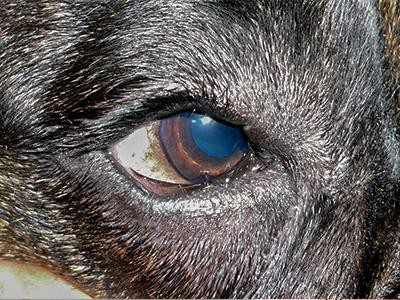
These are a sort of eyelash disorders that are found in Frenchies in which extra hairs grow out of the eyelash area.
Hemivertebrae
These are common Vertebral and spinal abnormalities found in French bulldogs. Breeds that have been bred purposely to have “screw tails” (French bulldog, English bulldog, Boston terrier, Pug etc) are at risk to this condition.
Hypothyroidism – This is the most commonly diagnosed hormone disorders in the dog and it is an inherited disorder of thyroid gland, causing slow physical and mental development.
Interesting Facts On French Bulldog
- The Industrial Revolution Played Important Role with the Breed as the French Bulldog originated at that time when English Bulldogs were bred with Pugs and Terriers by Nottingham lace workers after bull-baiting was banned in England in 1835.
- Early in the breed’s history, however, one could find many Frenchies with “rose” ears, i.e. similar to English bulldog’s ears. American breeders standardized the bat ears as they are more distinctive.
- The French Bulldog Club of America (FBDCA) is the oldest club in the world dedicated to the French Bulldog and the French Bulldog gained official recognition from the club in 1897.
- This was one year earlier than it was recognized as an official breed by the American Kennel Club.
- It’s reported that the well-known French Bulldog breeder Robert Daniel and his French Bulldog, Gamin de Pycombe were en route to New York aboard the Titanic in 1912 for the Frenchies specialty show.
- Daniel survived the sinking of the Titanic and still managed to turn up on time for the show. Gamin was last seen futilely swimming for his life in the sub-zero waters. And, not really sure whether the Frenchie met JACK and ROSE on board or not?
- The French bulldogs were favored by the late-19th and early-20th-century Parisian “Belles de Nuit”(aka prostitutes) which is one of the most crucial influences in growing the French bulldog’s popularity.
- The French bulldogs exploded in popularity among Americans as earlier in 1913 itself, when 100 Frenchies competed in the Westminster Kennel Club Dog Show.
- The Waldorf Astoria luxury hotel in New York City rented a ballroom to the FBDCA for a special breed show in 1898.
- French Bulldogs are paw-tastic on the big screen are Hollywood’s sweethearts. Some movies to watch for this beloved dogs stealing the show are “Secondhand Lions”, “From Hell,” “Titanic,” Bringing down the House” etc
- The Great Depression wreaked havoc in almost all corners of the world and franchise were also not spared. By 1940s, the number of Frenchies reduced to just a handful of them and these pets were considered a rare breed then.
- These little lovelies have earned themselves the soubriquet “Frog Dogs,” due to the odd way like a frog; they will lie on their tummies and splay their legs back behind them. So weird, and yet so cute!
- And the interesting facts about this adorable weirdos will go on and on …. Seems to have no end
French Bulldog Price And Breeders
French Bulldog Price
Average – $1500 – $3000 USD (USA), £1500 for KC Registered, £1300 for Non-KC Registered (UK)
The current median price for all French bulldogs sold is $2,200 USD. You should budget anywhere from $5,500-$10,000 for a French bulldog with top breed lines and a superior pedigree.
Of course, if you are lucky, you can always adopt a French bulldog for much less. Pet adoption from animal shelters and breed rescue organizations usually ranges from $400-$550 and includes registrations and vaccinations.
French Bulldog Breeders
Check out who made our list for the most reputable French Bulldog breeders of America in 2018.
- Premier French Bulldogs Chandler, Oklahoma
- Rolling Hills Frenchies West Plains, Missouri
- Little Frenchie Kisses Pinon Hills, California
- Pin Oak Kennels Purdy, Missouri
- Allusion French Bulldogs Murrieta, California
- Jolie French Bulldogs Santa Monica, California
- Starlette Frenchies Peyton, Colorado
- Copen’s French Bulldogs Alameda, California
- Carob French Bulldogs Fallbrook, California
- Starlette Frenchies Peyton, Colorado

